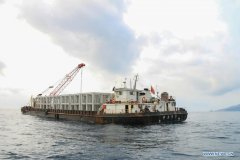US West prepares for possible 1st water shortage declaration
U.S. water officials are projecting the man-made lakes that store water used throughout the American West will fall to historically low levels and trigger an official shortage declaration for the first time
April 17, 2021, 11:30 PM
5 min read
Share to FacebookShare to TwitterEmail this articleFILE - In this July 28, 2014, file photo, lightning strikes over Lake Mead near Hoover Dam that impounds Colorado River water at the Lake Mead National Recreation Area in Arizona. The Bureau of Reclamation is forecasting first-ever water shortages because of falling levels at Lake Mead and says the reservoir could drop so low that it might not be able to generate electricity at Hoover Dam. (AP Photo/John Locher, File)
CARSON CITY, Nev. -- The man-made lakes that store water supplying millions of people in the U.S. West and Mexico are projected to shrink to historic lows in the coming months, dropping to levels that could trigger the federal government's first-ever official shortage declaration and prompt cuts in Arizona and Nevada.
The U.S. Bureau of Reclamation released 24-month projections this week forecasting that less Colorado River water will cascade down from the Rocky Mountains through Lake Powell and Lake Mead and into the arid deserts of the U.S. Southwest and the Gulf of California. Water levels in the two lakes are expected to plummet low enough for the agency to declare an official shortage for the first time, threatening the supply of Colorado River water that growing cities and farms rely on.
It comes as climate change means less snowpack flows into the river and its tributaries, and hotter temperatures parch soil and cause more river water to evaporate as it streams through the drought-plagued American West.
The agency’s models project Lake Mead will fall below 1,075 feet (328 meters) for the first time in June 2021. That's the level that prompts a shortage declaration under agreements negotiated by seven states that rely on Colorado River water: Arizona, California, Colorado, Nevada, New Mexico, Utah and Wyoming.
The April projections, however, will not have binding impact. Federal officials regularly issue long-term projections but use those released each August to make decisions about how to allocate river water. If projections don't improve by then, the Bureau of Reclamation will declare a Level 1 shortage condition. The cuts would be implemented in January.
Arizona, Nevada and Mexico have voluntarily given up water under a drought contingency plan for the river signed in 2019. A shortage declaration would subject the two U.S. states to their first mandatory reductions. Both rely on the Colorado River more than any other water source, and Arizona stands to lose roughly one-third of its supply.
Water agency officials say they’re confident their preparation measures, including conservation and seeking out alternative sources, would allow them to withstand cuts if the drought lingers as expected.
"The study, while significant, is not a surprise. It reflects the impacts of the dry and warm conditions across the Colorado River Basin this year, as well as the effects of a prolonged drought that has impacted the Colorado River water supply,” officials from the Arizona Department of Water Resources and Central Arizona Project said in a joint statement.
In Nevada, the agency that supplies water to most of the state has constructed “straws” to draw water from further down in Lake Mead as its levels fall. It also has created a credit system where it can bank recycled water back into the reservoir without having it count toward its allocation.
Colby Pellegrino, director of water resources for the Southern Nevada Water Authority, reassured customers that those preparation measures would insulate them from the effects of cuts. But she warned that more action was needed.
“It is incumbent upon all users of the Colorado River to find ways to conserve,” Pellegrino said in a statement.







